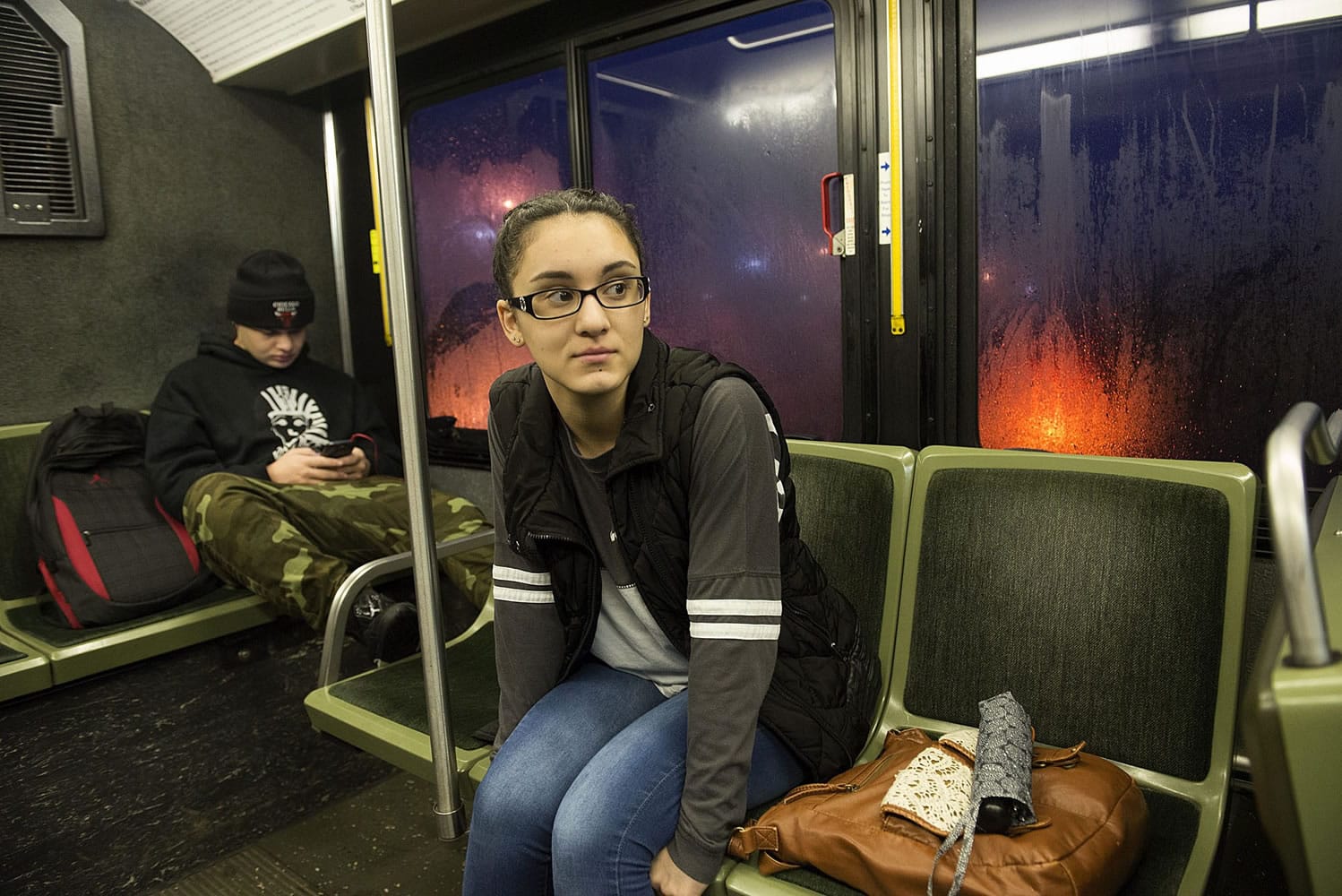Mountain View High School student Selena Vera ducked out of a torrential downpour and into a C-Tran bus so early Thursday morning that it was still dark. After showing her bus pass to the driver, she settled onto a seat and set down her bag.
Selena used to have to scramble every morning to find $1.25 in bus fare to get to school. Sometimes her dad remembered to leave bus fare on the kitchen table, but sometimes he forgot.
In November, the 16-year- old received a Youth Opportunity Pass at school, and she uses it to ride a C-Tran bus to school every morning. Now her early mornings are a little less hectic.
The high school junior is attending Mountain View on a boundary exception. Last spring, her family moved from a two-level house near her school in the Evergreen district to a one-level house in Vancouver. Selena’s grandmother, who lives with her family, couldn’t walk up stairs anymore, Selena said.
Moving out of the school district meant that Selena no longer could ride a school bus, and she had to pay to ride a C-Tran bus.
Devante Wood, a student at Legacy High School, wanted to earn school P.E. credit by working out regularly at Firstenburg Community Center, but he couldn’t afford a monthly membership. Last fall he was working two jobs after school and on weekends to save money to buy a fitness pass. Then his school counselor gave him a Youth Opportunity Pass — which is both a Firstenburg pass and a bus pass. The program helps low-income students who might have difficulty getting to school, jobs or activities.
Selena and Devante aren’t alone in receiving the Youth Opportunity Pass. The pilot program allows up to 1,500 qualifying middle school and high school students in the Vancouver and Evergreen school districts to receive the passes. Eligibility is determined by school staff, in part based on the students who qualify for free or reduced-price lunch.
Roughly half the students in the Vancouver and Evergreen districts are low-income. It’s tough for their families to have to pay for public transit for their teens. Often these students can’t get to after-school activities or jobs.
“We have to level the playing field,” said Bart Hansen, Vancouver city councilor. “When you couple the bus pass with the access to the community centers, you’re giving kids a place to go and a means to get there.”
He credits school board members in both Vancouver and Evergreen school districts, C-Tran board members and the Vancouver city council for working together to create the Youth Opportunity Pass.
“Getting four public agencies together to agree on one thing is not always the easiest thing on Earth,” Hansen said. “But when people saw the potential of this idea and we started talking dollars, that’s when people started getting excited about this idea and saw it was doable.”
Here’s how it works: C-Tran provides funding for transportation. The city offers the recreation piece by providing passes to Marshall and Firstenburg community centers. The school districts do the administrative work to get the passes into the hands of the youth who can use them.
“Everybody’s doing their part. This couldn’t have happened without those agencies stepping up and seeing that it was worth it,” he said.
With the Youth Opportunity Pass, students can travel throughout C-Tran’s C-Zone “basically anywhere the transit agency serves within Clark County,” said Christine Selk, C-Tran spokeswoman.
That includes a handful of routes that also connect to Portland, including Jantzen Beach, Delta Park/Vanport MAX Station and Parkrose MAX Station. The pass is not valid on C-Tran’s express buses into downtown Portland or on TriMet, Selk said. If the students had to purchase the student C-Zone pass, they would pay $30 per month.
Students can use the fitness pass at either Marshall or Firstenburg community centers. Both centers offer free after-school opportunities for teens, including open gym and activities in the teen center, said Dave Perlick, recreation manager, city of Vancouver Parks & Recreation.
In addition, students also can apply for a second free access pass to work out in the fitness center and use the pool at both facilities. At Firstenburg they also can use the indoor running track and the climbing wall. If the Opportunity Pass holders had to purchase an all-access pass for youth at either community center, it would costs $20 per month for city residents and $23 for nonresidents.
“We’re trying it out and seeing how it works,” Perlick said. “So far, it’s been great.”
Hansen would like to see the Youth Opportunity Pass expanded to other Clark County cities and school districts with C-Tran routes, and he’d like to double the amount of passes for Evergreen and Vancouver districts.
“It’s a win-win for the youth,” he said.




